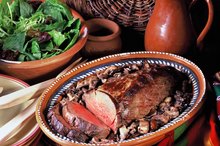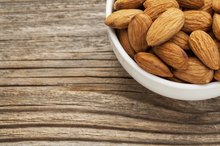What does fact checked mean?
At Healthfully, we strive to deliver objective content that is accurate and up-to-date. Our team periodically reviews articles in order to ensure content quality. The sources cited below consist of evidence from peer-reviewed journals, prominent medical organizations, academic associations, and government data.
The information contained on this site is for informational purposes only, and should not be used as a substitute for the advice of a professional health care provider. Please check with the appropriate physician regarding health questions and concerns. Although we strive to deliver accurate and up-to-date information, no guarantee to that effect is made.
Nutrition Information for Turkey Lunch Meat
In general, turkey is one of the healthier choices for a sandwich. Sliced turkey is high in protein and low in fat, and when combined with whole-wheat bread and vegetables, it can make a nutritious lunch. Sliced turkey is low enough in fat that you can add 1 tbsp. of low fat mayonnaise to your sandwich and still have a meal that contains less than 11 g of fat.
Tips
Turkey Lunch Meat has 482 Calories and 8.93 g of Protein per 100 gram serving according to the nutrition facts provided by the USDA Food Composition Database.
Calories
Turkey lunch meat is lower in calories than most other lunch meats. A 100 g, or about 3.5 oz., serving of sliced turkey contains 99 calories. The same size serving of pastrami contains 147 calories, and the same amount of ham contains 163 calories. Other lunch meats, such as salami, are even higher in calories, with 388 calories per serving.
- Turkey lunch meat is lower in calories than most other lunch meats.
- Other lunch meats, such as salami, are even higher in calories, with 388 calories per serving.
Protein
Gyro Meat Nutritional Information
Learn More
One serving of turkey lunch meat contains 17.1 g of protein, which provides 69 percent of the calories. Turkey is composed of higher percentage of protein than other lunch meats; pastrami is 60 percent protein, ham is 41 percent and salami is only 21 percent. The 17.1 g of protein in sliced turkey supplies 37 percent of the recommended daily amount for most women and 31 percent for most men.
Fat
Turkey lunch meat is lower in fat than most other lunch meats. One serving of sliced turkey contains 2 g of fat, which supplies only 18 percent of the 99 calories. Pastrami contains more than twice as much fat, with 5.8 g, which makes up 37 percent of the calories. Ham and salami are even higher in fat, with ham containing 8.6 g and salami containing 33.3 g, which are 48 and 77 percent of the calories, respectively.
- Turkey lunch meat is lower in fat than most other lunch meats.
- One serving of sliced turkey contains 2 g of fat, which supplies only 18 percent of the 99 calories.
Carbohydrates
Nutrients in Bologna
Learn More
Most lunch meats are low in carbohydrates, and turkey is no exception. One serving of sliced turkey contains 3.25 g of carbohydrates, which provides only 13 percent of the calories. Like most lunch meats, sliced turkey contains no fiber. However, if you use turkey to make a sandwich on whole wheat bread, the sandwich would contain 3.8 g of fiber, which is 14 percent of the recommended daily amount for most adults.
- Most lunch meats are low in carbohydrates, and turkey is no exception.
- One serving of sliced turkey contains 3.25 g of carbohydrates, which provides only 13 percent of the calories.
Sodium
Although it is lower in sodium than ham or salami, turkey lunch meat still contains a high percentage of the daily allowance. Because sodium can contribute to health problems, such as heart disease, it is recommended that you consume less than 2,300 mg per day. The American Heart Association suggests even less, 1,500 mg per day, if you are at risk for heart disease 1. One serving of turkey lunch meat contains 966 mg, which is 64 percent of this amount. If you are at risk for heart disease, or wish to stick to a low-sodium diet, you may wish to use low-salt turkey, which contains 772 mg per serving.
- Although it is lower in sodium than ham or salami, turkey lunch meat still contains a high percentage of the daily allowance.
- If you are at risk for heart disease, or wish to stick to a low-sodium diet, you may wish to use low-salt turkey, which contains 772 mg per serving.
Related Articles
References
- American Heart Association: Sodium
- Center for Nutrition Policy and Promotion: Nutritional Goals
- FoodData central. Turkey, all classes, leg, meat and skin, cooked, roasted. U.S. Department of Agriculture. Updated 2019.
- Martone AM, Marzetti E, Calvani R, et al. Exercise and protein intake: A synergistic approach against sarcopenia. Biomed Res Int. 2017;2017:2672435. doi:10.1155/2017/2672435
- Cao Y, Strate LL, Keeley BR, et al. Meat intake and risk of diverticulitis among men. Gut. 2018;67(3):466-472. doi:10.1136/gutjnl-2016-313082
- Iron: Fact Sheet for Health Professionals. National Institutes of Health, Office of Dietary Supplements. Updated 2020.
- Skerrett PJ. Turkey: A Healthy Base of Holiday Meals. Harvard Health Publishing, Harvard Medical School. Updated 2012.
- Meat Allergy. American College of Allergy, Asthma & Immunology. Updated 2019.
- Laatsch DR. Raising turkeys as a 4-H or FFA project. Extension Dodge County University of Wisconsin-Madison. Updated 2012.
- Let's Talk Turkey—A Consumer Guide to Safely Roasting a Turkey. U.S. Department of Agriculture. Updated 2015.
Writer Bio
Lisa Thompson has been writing since 2008, when she began writing for the Prevention website. She is a holistic health practitioner, nationally certified massage therapist and National Council on Strength and Fitness-certified personal trainer. Thompson also holds certificates in nutrition and herbology from the Natural Healing Institute, as well as a Master of Education from California State University.









